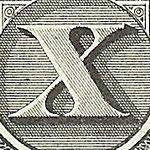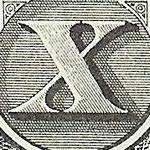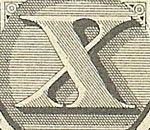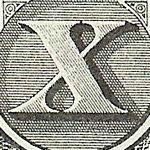Counterfeit $10 dos caritas
Correspondence
On 27 January 1915 de la Garza sent Navarro, at Norris Peters, a counterfeit $10 note (series number 249481) and asked for the firm’s commentsLG papers, 6-D-37, letter from de la Garza, El Paso, to Navarro, Washington, 27 January 1915. De la Garza had also seen counterfeit $5 notes. A week later Navarro replied that the note was lithographed (hecho en piedra) and poorly done. It was obviously false at first sight, but even more differences were visible under a magnifying glass. The experts in Washington thought that the Government Palace and the figures around it were the only part that was exactly the same as on a genuine note, so they were of the opinion that the image of the Palace had been taken from the original stone (which was in Navarro's possession) or that the person who made the plate stole or, rather, possessed a similar one. They based this opinion on the fact that the images such as the car, people and shades kept the same relative distances as on the genuine notes, a difficult feat to copyLG papers, 6-E-7, letter from Navarro, Washington, to de la Garza, El Paso, 3 February 1915.
This is probably the same counterfeit that de la Garza wrote to Vargas about in February 1915. The differences that de la Garza noted, and marked up, on his example in his letter to Vargas were
| GENUINE | COUNTERFEIT |
|---|---|
|
|
“X” closed (cerrado abajo) |
| secret printer’s marks | |
| strokes of the 'E' are larger (Las rasgas de la E son mas largos en los nuestros) |
|
| shadows of the ‘E S’ are different (Las sombras de las E.S son diferentes) |
|
| has part of a star (El billete falso tiene parte de una estrella el nuestro no la tiene) |
|
| figura touches the figuras above | space between figuras |
| triangles are larger and ray clearer (Los triangulos son mas grandes en el nuestro y el rayado mas claro) |
|
| IE’ separate (En nuestros billetes la IE estan separadas y en los falsos juntos formando lo negro una O) |
‘‘IE’ joined, so black forms an ‘O’ |
| Shadows of ‘A’ different (Las sombras de la A son distintas) |
|
| figura touches side | space |
|
(la linea recta casi hasta arriba de la Estrella y hace curva) |
line is curved |
sal la curva donde acaba la linea |
esta metido debajo de dicha linea |
| three decorations in the ‘10’ are larger and different (Las tres figuras en el 10. en nuestro billete son mas largas y diferentes en todo al falso) |
|
(dos manchas blancas. y la raya negra llegar casi a tocar la otra y hace curva el recta) |
|
| Detail separated from the circle of the ‘10’ (En nuestro billete sal la curva donde acaba la linea en el falso esta metido debajo de dicha linea) |
Detail touches the circle |
(La X esta separada y la sombra hace una linea recta y depues quiebra recta) |
(quiebra con curva) |
| the shading of the letters is unbroken, without gaps (Las sombras de todas las letras son diferentes, las nuestras son seguidas y casi sin espacios, los falsos tienen muchos espacios) |
the shading had many gaps |
 |
 Chao’s signature different |
(limpia) |
(la j tiene una linea que mas bien parece un rasgo de la o) |
| Portraits and portraits’ shading different (Las sombras de los retratos y aun los mismos retratos son diferentes) |
|
| Two (Esta figura en el nuestro tiene dos el falso tiene tres) |
Three |
| (Son diferentes y todo el rayado de diez pesos es diferente en el nuestro puedes notar las sombras de las letras en el falso no.) |
|
| Background on reverse does not touch sides but leaves a white space (el rayado o fondo en los nuestros no toca con las lados y deja un espacio blanco el falso toca) |
Background touch sides |
whilst Vargas' instructions to Saravia, dated 6 February, gave the followingADUR, gaveta 6, nombre 88:
| GENUINE | COUNTERFEIT |
|---|---|
|
|
Both ‘X’s are joined at top and bottom |
| In Vargas’ signature there is only a small line between the letters ‘rg’ | There is an extra dot between the letters |
| The ‘IE’ of ‘DIEZ’ in the upper corners are separated | The ‘IE’ are joined |
| The upper curve of Vargas’s signature is regular (regularmente marcada) | Curve appears a little crushed (un poco aplastada) |
| paper is slightly glossy (lustroso) | paper is very dull and rough (muy opaco y aspero) |
The other contemporary comment was from Navarro.
| GENUINE | COUNTERFEIT |
|---|---|
| based on the original plate but the Palace and the figures around it are the only features that are exactly the same |
Urbano Treviño, in Coahuila, gave the following characteristics of a counterfeit $10 Series D noteACOAH, Fondo Siglo XX, 1914, caja 8, folleto 4, exp. 13.
| GENUINE | COUNTERFEIT |
|---|---|
|
The [top of the righthand] Roman numeral ‘X’ is separated |
The [top of the righthand] ‘X’ is completely closed |
|
The end of the ‘Z’ in ‘DIEZ’ is rounded |
The lower part of the ‘Z’ in ‘DIEZ’ is straight |
|
|
The ‘E’ of ‘El’ is less acute and has a (desviada) shadow at one of its ends |
|
The centre frame has an extra half star with two points |
The centre frame has no particular |
| The seal and serial numbers are litographed | The seal and serial numbers are ferrotype |
This is probably Counterfeit $10 Type 1.
Portraits
Again there are differences in the Madero portrait. Types1-4 are genuine printings, whilst Types 5-8 are counterfeit
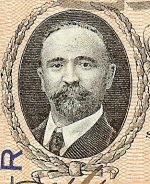 |
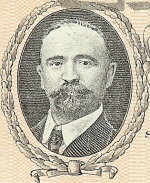 |
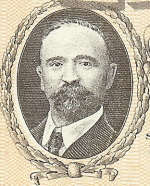 |
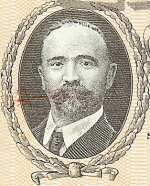 |
| Type 1 | Type 2 | Type 3 | Type 4: smoother nose |
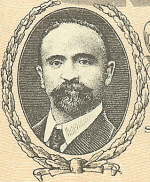 |
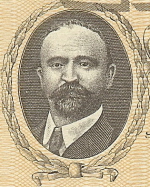 |
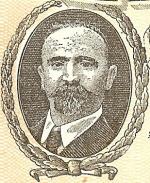 |
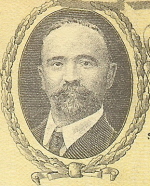 |
| Type 5 | Type 6 | Tpe 7 | Type 8 |
and differences in the González portrait. Again Types1-4 are genuine printings, whilst Types 5-8 are counterfeit
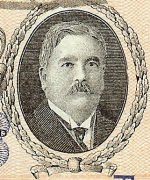 |
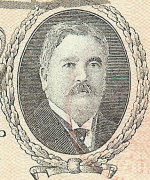 |
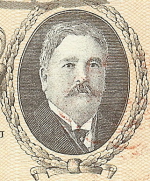 |
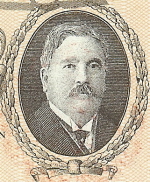 |
| Type 1 | Type 2 | Type 3 | Type 4 |
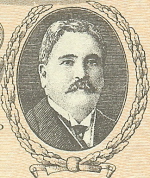 |
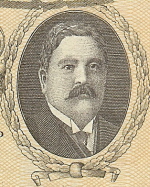 |
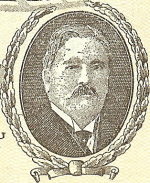 |
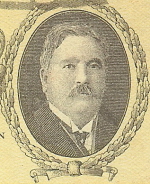 |
| Type 5 | Type 6 | Type 7 | Type 8 |

